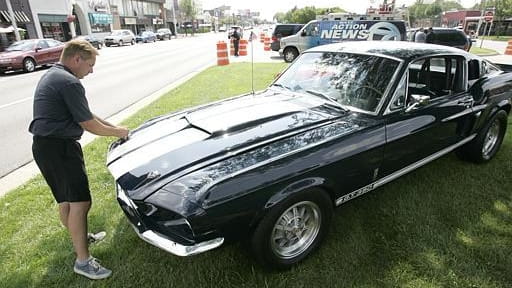In classic car restoration, a contract is key

Jarrod Kings closes the hood on his 1967 Ford Shelby Mustang GT-350 in Ferndale, Mich. (Aug. 16, 2005) Credit: AP
Who among us has not at some time imagined doing a comprehensive high quality restoration on the car of our dreams? Perhaps it’s a car that we already own, or one that we would buy for the sole purpose of restoring. For some, the thought of undertaking such a project is a dream. For others, it’s a nightmare. As with so many other things in life, how well you prepare and how realistic your expectations are, will determine whether you wake up in the morning with the warm fuzzies, or in the middle of the night in a cold sweat.
A restoration to high standards on just about any car will begin at about $50,000 and can easily climb into the millions on many exotic cars. Most of the cars that we drive will be in the $50,000 - $100,000 range, not including the cost of the car. This is a substantial amount of money, yet I regularly make new friends who contact me when they discover that they’ve written out $150,000 in checks for a restoration that was supposed to cost $50,000. And the worst part is that it’s been two years since work began and the car is still not even back on the frame. Maybe it’s a sign of the times, but I am retained on cases of this type at a rate of at least one a week.
In most cases the blame must be shared between the restoration shop and the customer. Some restoration shops simply get in over their heads, and some are just outright criminals. But what customer in their right mind continues writing out checks without tallying up a total or checking on the progress of the restoration?
There is no way to guarantee that any restoration will be completed on time, and on budget. But without a written contact, I can guarantee it won’t. This is the case even with an honest shop, and a customer willing to keep the cash flowing. That’s because a restoration is a complicated undertaking, and unless things are reduced to writing, the expectations of both the customer and the restoration shop will be different. These expectations can apply to the payment schedule, the work schedule, and the level of quality of the work to be performed.
Three cases that I’m currently involved with can be used to exemplify what can go wrong. The models of the cars are slightly altered to keep those involved anonymous.
The first is a 1970 Buick Skylark Coupe. The car was a nice solid car with a minimal amount of rust. The owner entrusted the restoration to a shop without a written contract, but was verbally told to expect a total cost of about $50,000. Clearly it does not pay to spend this kind of money to restore this car, but he had an emotional attachment, so he went ahead. Two years and $160,000 later the car is still in pieces. He just removed the car from the shop and gave it to another shop to complete. Hopefully it will come out nice. It should for a total cash outlay of almost $200,000. All of this could have been avoided had a contract been prepared.
The second car is a 1968 Cougar GT Convertible. It was in average condition and needed a slightly more comprehensive restoration, including replacement of the floors. The restoration far exceeded the expected budget, exceeding $100,000. The unfortunate part is that the quality of the workmanship is so poor that the car has virtually no value. In all likelihood the owner will end up parting the car out, and recovering some of his money in court. This could have been avoided had periodic inspections been made during the restoration.
The third car is a 1967 Shelby GT350. The budget for the restoration was slightly in excess of $150,000. The owner and the restoration shop went to great lengths to draft a fairly inclusive contract including a payment schedule and a deadline. This car came in right on budget, but was over six months late. The owner of the car is absolutely disgusted because he did not get to enjoy his car before winter set in, and the restorer is frustrated because he feels that he did a restoration to the highest standards, and time should take a back seat to quality. I’ve inspected this car, and the workmanship is second to none. The car is stunning, but we still have an unhappy owner and restorer. This is the best-case scenario of what can go wrong during a restoration. But in my experience, owners tend to forget the delays if the car comes beautiful, out on time, and on budget.
This brings me to my earlier point about expectations. Expect the restoration to go over budget to some degree, perhaps 10%. After all, we’re talking about cars whose ages are measured as a percentage of a century and the truth is that a restoration shop won’t really know the true extent of the work to be completed until they disassemble the car. Expect it to take longer than planned by a few months. Expect to make scheduled visits to verify that the work that you are getting billed for is actually getting done. And expect to pay those bills on time and in full if the work is getting done. You won’t be disappointed with your experience if you expectations are realistic.
